The Simple Guide to Startup Product Development: From Ideation to Launch

Every great product started somewhere. In a meeting room full of developers throwing around ideas on a whiteboard. Or during a remote video call that turned into an international brainstorming session.
But there are also a lot of great ideas that don’t make it to launch day. A delay during prototyping or a lack of feedback from testing can sink a new product. Fast. That’s why a solid startup product development strategy is the smartest way to keep every product on track, from the meeting whiteboard to your post-launch party.
I’ve built a few products over the years, including Close, so I know a thing or two about what goes into making the product development process a success. Let’s take a look at how to get an idea from ideation to launch in five steps, and some methodologies you can use to manage the whole thing 👇
The Full Product Development Process for Startups in 5 Steps
Product development isn’t an overnight process.
Most entrepreneurs use a roadmap to plan out what products they will build over the upcoming weeks, months, or even the entire year. These product development cycles tell dev teams exactly what is in the pipeline and when products need to be delivered. This also gives other departments, like marketing and sales, a rough idea of when they need to think about pitching the new releases to customers.
These product roadmaps have a lot of steps, from product conceptualization to design, development, testing, and finally—the launch itself.
Let’s take a closer look at the stages of product development 👇
Step 1. Idea Generation & Concept Development
Idea generation is the first step in any new product development process. It involves coming up with an idea that solves a problem or meets customer needs. This can be done through brainstorming sessions, customer feedback, or market research.
Ask your development team to grab their notebooks, book a meeting on their calendar, and start brainstorming. At a basic level, you should start to generate ideas based on a couple of questions:
- Who is the product for? Even in the early stages of development, each product must relate to your target market. Think about what needs current customers have and if there is a product-market fit.
- What will the product do? You don’t need a detailed breakdown of all the new features the product will have, but it’s important to know what the product will do, what pain point it’ll solve, and who will need it.
- What are your competitors doing? Do similar products already exist in your industry? What do they look like, what kind of features do they have, and how long would it take you to make a product that can realistically rival it?
When you get your team together like this, try not to shoot anyone down. There’s no such thing as a shit idea. Put everything on the table and make sure your developers know that every idea will be discussed.
I recently discussed how to create a software product your customers actually need with Eric Siu—check out our convo here:
Step 2. Product Design
This step involves creating a detailed design of what you want the product to look like and how it should function. It’s also a good idea to think about the end-user, which will be your customer, so you can design the product in a way that meets their needs and solves their problem.
Ask your design team (if you’ve got one) to participate in this stage, as they can help with the visual concept of the product. When creating a physical product, begin by crafting a detailed hand-drawn sketch that includes essential aspects such as measurements, features, and functions. For digital products, it can be a mock-up with rough components and workflows.
Google designer Mariam Shaikh says even though the company is high-tech, the team usually starts the design process with a paper sketch.
“Sketching is great when thinking through all the initial ideas running through your head. You can sketch to outline the steps in a user flow, explore a variety of layouts, and show a basic app structure or what we commonly call a wireframe,” she says.
“The more you can flesh out your ideas on paper, the faster you’ll move on your computer.”
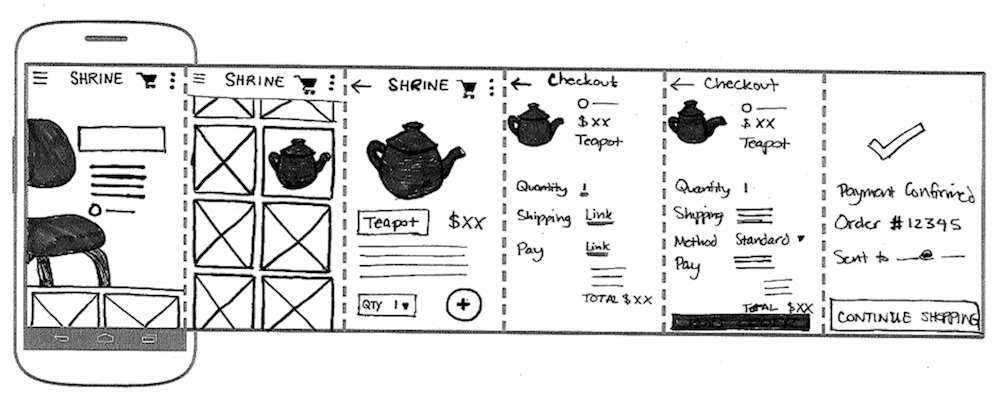
Remember, the design doesn’t have to be perfect. It’s better to have a rough idea to give to your software development team so they can get started rather than spend months perfecting a diagram.
Step 3. Prototyping
Prototyping is the process of creating a mockup of the product. This can either be digital or physical, depending on what you are making.
This step is crucial because it brings your idea to life. Before this, it was all brainstorming and sketches, but building a prototype gives you a shot at testing the product’s functionality and usability. It also allows you to spot any design flaws or issues with the ideation and design so you can make tweaks before launch.
In this phase, your team will look at:
- Development strategy. Who will be responsible for running this development and keeping people on track? Which team members will be in charge of what tasks? It’s best to build out a detailed timeline and estimate how long this is all going to take
- Product fit. Never forget who you are making the product for. During mid-development, it’s okay to rethink the initial design and tweak it to include new ideas or features that customers may need
This information, along with your initial design sketch, can then be used to build out a Minimum Viable Product (MVP). For example, Google’s product dev team turned the initial sketch we talked about in step three into a digital prototype to show stakeholders and use for beta testing.
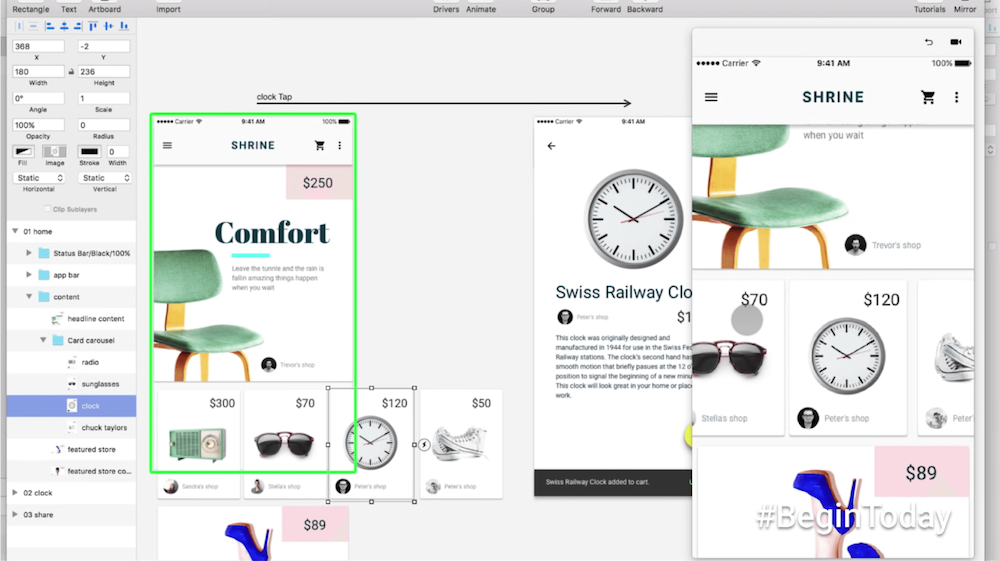
This MVP is a bare-bones product that you’re happy enough with to launch to customers.
Is it perfect? No.
But it helps get into a customer’s hands to get valuable feedback and insights so you can turn it into a successful product.
Step 4. Testing
Next, put the product through its paces and get some validation that it actually works.
Evaluate the product’s performance, test it with users, and make sure it meets quality standards before launch day. It’s much easier to smooth out any kinks in-house before you hand it over to potential customers to scrutinize.
This step is also where you should start to think about pricing. And my advice is to always, always, always charge more, especially if you’re an early-stage founder building a B2B business.
Why?
Well, a cheap product usually signals to people that it’s going to suck. But most founders price their product low anyway, so prospects won’t haggle. This is not the right way to set prices for your product because no matter how much you charge, you will never make every customer happy. What you should aim for is what I call the pricing sweet spot:
- 20 percent of the prospects will gawk at your prices for being too expensive and won’t go any further
- 20 percent of people will think it’s cheap and even hint that they would pay more
- 60 percent of customers think your product is worth what you charge. They think it would be nice if it was a little cheaper, but all in all, the value proposition outweighs the price
That’s the pricing sweet spot.
Step 5. Launch & Post-Launch Assessment
It’s game day.
This is the last step in the development process and when you release your final product to customers. Now, what the launch actually looks like will vary wildly depending on what industry you’re in. Clothing retailers may throw a party at a brick-and-mortar store, while SaaS startups can use remote events to promote the new product to customers.
When Hiten Shah launched Draftsend, he leveraged early adopters already using the product to help out. Around 20 Draftsend customers recorded videos for the launch and talked about why they loved the product, and then Shah’s team shared this USG across the company’s social channels to build momentum.
“We didn’t pick out these people because they were influencers, we just knew they would have good things to say,” he says.
“Our goal was just to demonstrate what the product could do and have enough of these example videos so people can get inspired when they look at the product. That was a key part of our strategy, and if it wasn’t just our content, we knew more people would share it.”
After the launch was done, Shah said they focused on collecting as much feedback as possible to improve the product.
Now, listen to me when I say this: launches rarely go to plan. This stage will quickly reveal a product’s feasibility and if it’s going to sink or swim. When we launched Close, it was kind of messed up. We promised customers they would be able to close more deals—but we hadn’t even built reporting features.
Picture our post-launch assessment: customers said they loved us, and then they dumped us. And it was because they couldn’t track anything.
Our churn was nuts. But in a way, it was a good churn.
Close’s early adopters gave us a ton of good advice on what improvements our MPV needed. Over 6,000 startups and SMBs now trust our software to manage their sales pipelines, so we must be doing something right. But we sure as hell wouldn’t have gotten here without listening to feedback and improving the tool.
I talked about everything I’ve learned about product post-launches with Hiten Shah on The Startup Chat—listen to the episode here 🎧
The Most Common Startup Product Development Methodologies
There’s no “one-size-fits-all” when developing a product.
Some entrepreneurs build a Minimum Viable Product (MVP) to release to customers, while other companies will use sprints to build a new product in stages. So, you need to think hard about not only what your customers need, but also what your long-term product goals are, your development team’s bandwidth, and your overall budget.
Here are the most common product development methodologies startup founders use 👇
1. Agile Product Development
Agile development emphasizes adaptability and customer satisfaction through iterative progress. By breaking your product into manageable units, you allow your team to work on smaller tasks, ensuring progress while being able to incorporate feedback quickly.
The most popular framework for developers is Scrum, which involves cross-functional teams to plan out objectives, work on problems and tackle “sprints” of product development in blocks.
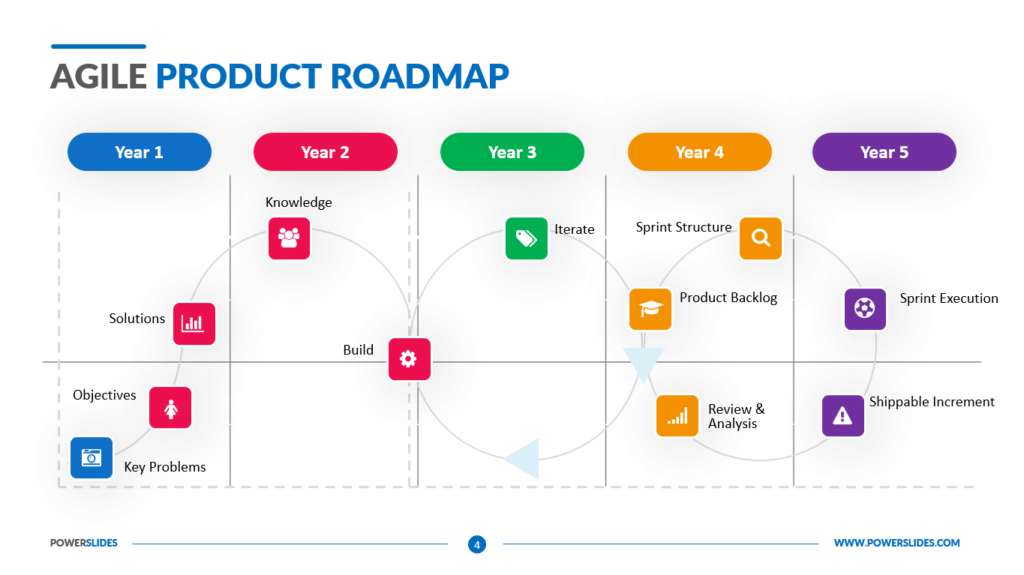
This methodology is a great choice for startups tackling complex problems. It gives you some movement to experiment while still keeping overall product development on track.
2. Waterfall Model
The Waterfall model is a more linear approach to product development. Basically, the one phase of the product development process cannot start until the current task has progressed to a certain stage.
When this method is mapped out, it looks like a waterfall:
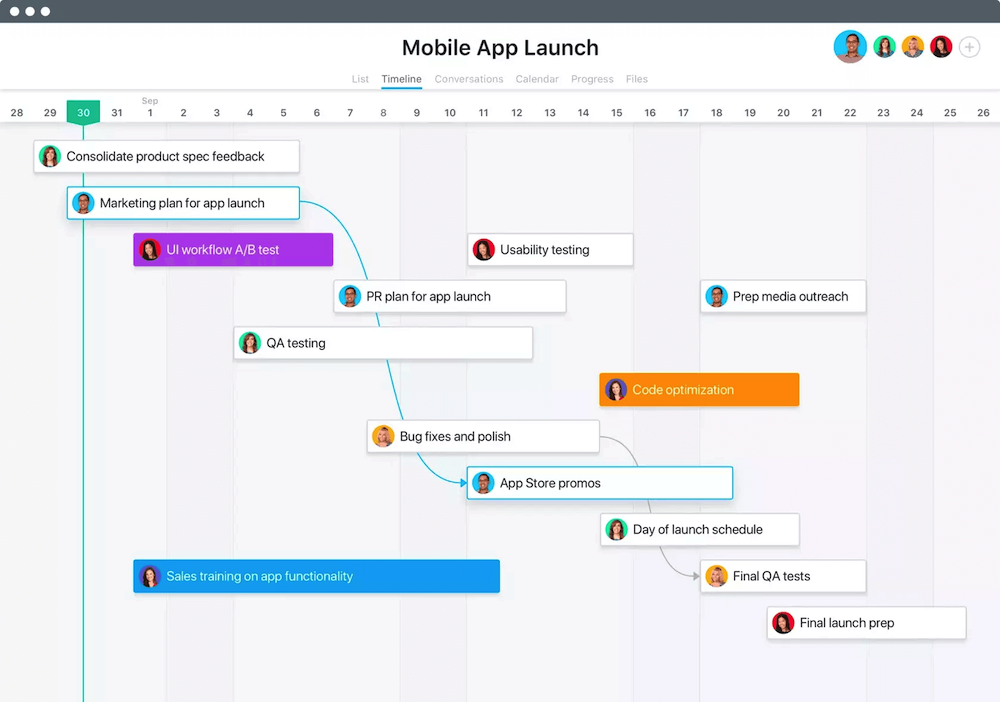
So, who should use it?
It’s perfect for product dev teams with a solid idea of the requirements and timeline for each process stage.
3. Lean Product Development
The Lean startup methodology is all about trimming the fat during the development process—no useless meetings or working on fancy-but-unnecessary features.
It sticks to the process you should follow to launch an MVP in a specific timeframe and gather feedback.
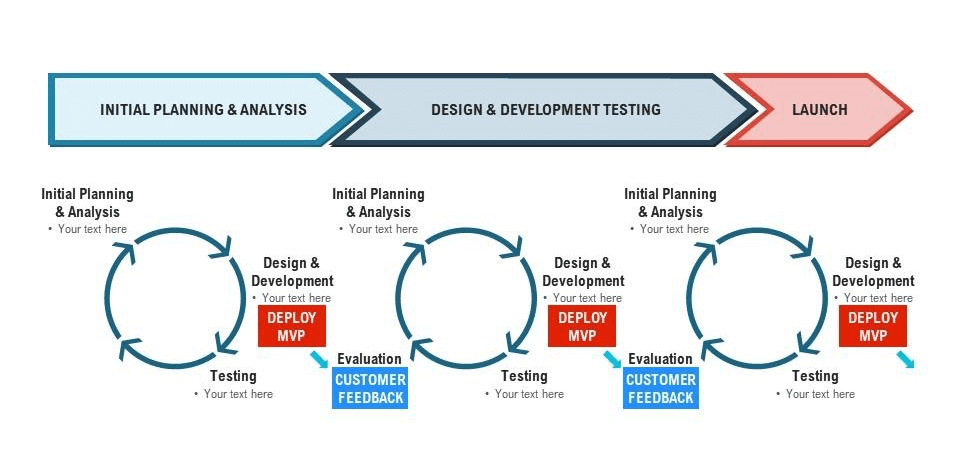
By tweaking the product based on customer feedback, this product development methodology keeps the end product focused on the customer.
4. Kanban
Similar to a sales pipeline, the Kanban methodology uses progress sections to track where products are in the development stage. Tasks can be split into sections, like design or prototype, and then ticked off or moved along the board once they are completed.
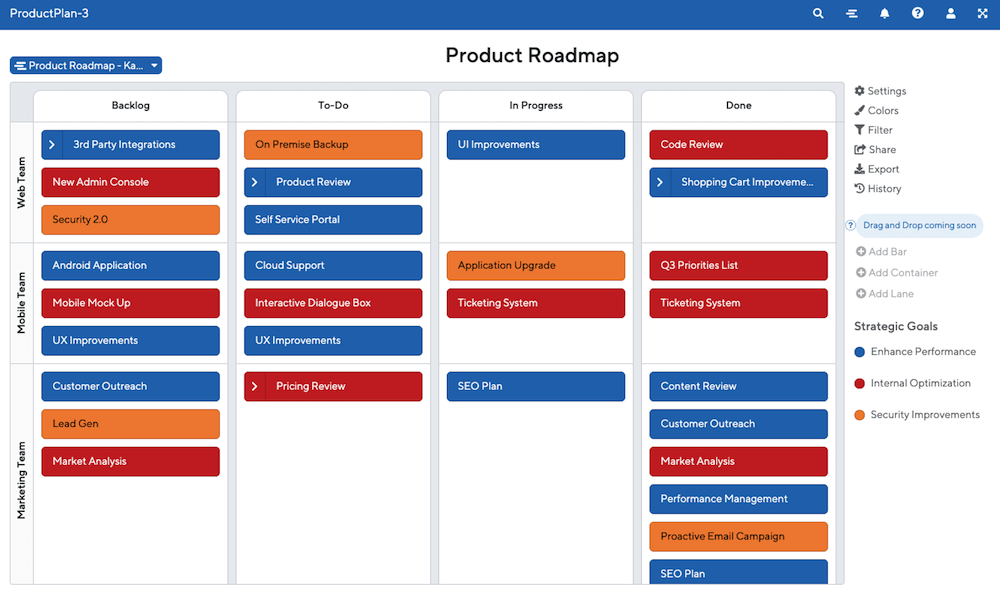
By splitting the development process up like this, you can prevent your team from feeling overloaded and keep them focused on small batches of tasks.
5. Spiral Model
The Spiral methodology is half Waterfall/half agile.
The framework can minimize the amount of risk involved in developing a new product by using multiple review rounds, prototypes and tests to ensure you get it right.
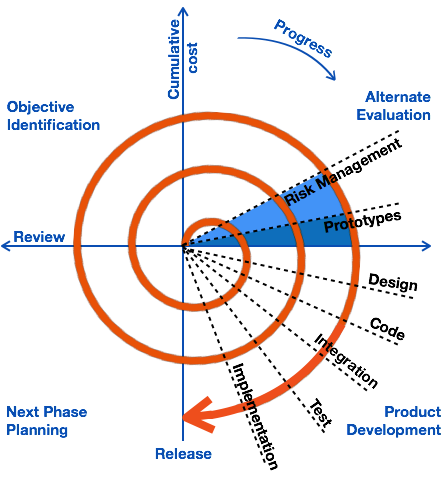
Yes, it takes longer than some of the other methodologies on our list, and it has more steps, so it’s not a great fit for small product builds. But for startups or SMBs building large, complex, expensive, and high-risk projects—it makes the process a little more watertight.
6. Extreme Programming (XP)
The final methodology on our list is Extreme Programming (XP).
Technically, this framework sits in the Agile family. It focuses on customer satisfaction and allows teams to build frequent “releases” in shorter development cycles, so products are released quickly but in a controlled way.
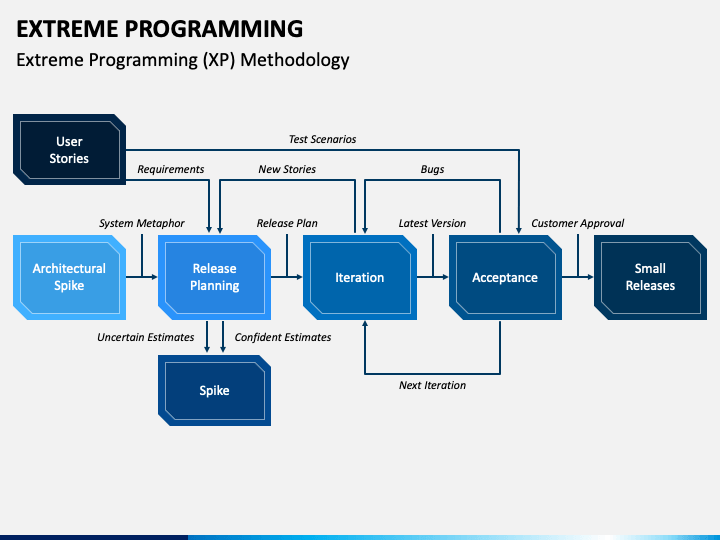
The framework has five phases (planning, analysis, design, coding, and testing) and is a good fit for tech startup dev teams who need to quickly adapt products and releases to changing software requirements.
Building the Best Product Comes Down to Planning
Not every product makes it out of the meeting room. There are even fewer that make it to the stage where they are seen by customers.
It’s the bits in between—the planning, the methodologies, the execution—that will make or break the product. Evaluate your customer’s needs, keep an eye on the market and what your competitors are developing, and think about your pricing early.
No matter what you build, remember always to bring it back to your target audience. At the end of the day, they’re the ones paying your bills—so give them something worth parting with their hard-earned cash.
Startup Product Development FAQs
What is the best product development methodology for startups?
The best product development methodology for startups depends on what you are building, but most of the time, the Agile framework is a solid choice. Agile allows for rapid iterations, last-minute changes based on user feedback, and quick adaptation.
How do you validate product ideas?
Validate product ideas by going straight to the source—your target customers. Engage them early on with surveys, interviews, and prototypes. Just make sure you listen to the feedback they give you because it’ll help you tweak the product and get you one step closer to a good product-market fit.
What are the most common mistakes to avoid during MVP development?
Product developments fail for all types of reasons. Most of the time, a company’s MVP falls victim to overengineering, minimal customer involvement, and delayed launch timelines because developers don’t know when to stop adding features.
What are the best tools for product design?
Product design tools largely depend on what kind of budget your company has. However, the tools teams most rely on are Sketch, Figma, and InVision, thanks to powerful features for creating visually appealing and user-friendly interfaces.
How do you measure the success of a product launch?
Keep track of every product launch using metrics like user adoption rate, revenue growth, customer satisfaction, and feedback from early adopters. These particular metrics will give you a rough idea of the product’s profitability and how happy your customers are.
Recent Comments